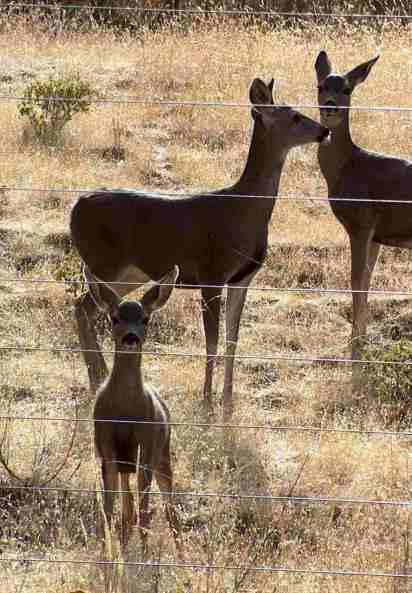Resource Islands
The term Resource Island was given to me by Gabor Bethlenfalay from Oregon State when he decribed a resoration in La Paz Mexico. I've adapted that thought into California and it's native plants and wildlife.If you're trying to restore a habitat or create a wildlife corridor you never have enough resorces. No one wants to pay the $50,000-100,00 per acre that is needed to do even a passable job in restoration of a native system. Weed control alone can eat up $1-5,000 per acre per year and you'll need to do that for at least 3 years. If you have a 50 acre ranch or farm you're trying to restore, very few of us are willing to, or have the ablity to pour that kind of money down a squirrel, deer, or rabbit hole. Thus resource islands.
Each resource island needs a fence to protect it from deer, rabbits and sometimes squirrels. The fence should be 30-50 ft. across and 6 ft. tall with chicken wire or small mesh covering the bottom 2 ft. or so. The islands should be between 100 to 300 ft. apart. If you only have the resources for one enclosure, put it about 100 ft. from an existing oak, pine or other native tree or bush.
Each resource island usually needs water for the year. We usually use a
microsprinkler, rainbird or MP-rotator to water a full circle and we
put the fence line where the circle of water covers. If the circle is
larger than 50 foot the deer will jump into the enclosure and actualy
live in the 'safe house'. If you like to gamble, you can try these
without irrigation, on wet years they will or just fine. On dry years
you will lose the entire planting.
The resource island should include a mixture of pioneer and secondary
pioneer plants from you area. Here are a few lists for different areas
of California. Use at least 5 species in each island.
South Coast, San Diego, Orange counties and up into Malibu within
20-50 miles of coast. Most of these should be fine in Riverside, Los
Angeles, Temecula, and Escondido.
Arctostaphylos glauca, Los Angeles Big Berry Manzanita or Arctostaphylos glauca, Ramona Big Berry ManzanitaArtemisia californica, California Sagebrush
Ceanothus megacarpusX Tranquil Margarita Big Pod California Lilac
Cercocarpus betuloides, Mountain Mahogany
Diplacus puniceus, Red Monkey Flower
Eriogonum parvifolium, Cliff Buckwheat
Malacothamnus densiflorus, Many Flowered Bushmallow
Rhus ovata Sugar Bush or Rhus integrifolia Lemonade Berry
Salvia clevelandii, Musk Sage
Salvia leucophylla Purple Sage
Salvia mellifera, Black Sage
Stipa pulchra, Purple Stipa
Central coast from Santa Barbara to Salinas and inland as far as Paso Robles and King City. These may work in Livermore, Patterson and maybe along the west side of the valley up to Davis. Los Banos south is too dry.
Arctostaphylos glauca, Big Berry Manzanita
Artemisia californica, California Sagebrush
Baccharis pilularis consanguinea Coyote Brush
Central and Northern California Lilacs
Eriogonum parvifolium, Cliff Buckwheat (next to coast) or Eriogonum fasciculatum foliolosum, California Buckwheat inland
Lupinus albifrons, Silver Bush Lupine
Pinus sabiniana, Gray Pine
Salvia mellifera, Black Sage
Artemisia californica, California Sagebrush
Baccharis pilularis consanguinea Coyote Brush
Central and Northern California Lilacs
Eriogonum parvifolium, Cliff Buckwheat (next to coast) or Eriogonum fasciculatum foliolosum, California Buckwheat inland
Lupinus albifrons, Silver Bush Lupine
Pinus sabiniana, Gray Pine
Salvia mellifera, Black Sage
Northern California coast.
Arctostaphylos stanfordiana stanfordiana, Napa ManzanitaBaccharis pilularis consanguinea Coyote Brush
Ceanothus Blue Jeans Holly Leaf Mountain Lilac
Ceanothus thyrsiflorus, Skylark Blue Mountain Lilac
Diplacus aurantiacus, Sticky Monkey Flower
Garrya elliptica, James Roof Silk Tassel
Monardella villosa subserrata, Coyote Mint
Pinus muricata Bishop Pine
Rhamnus californica, Coffeeberry
Symphoricarpos albus laevigatus, Common Snowberry
Zauschneria or Epilobium, California Fuchsia
After a year or so, turn the water off and take the fence down. You can move it to the next section for the next years planting. After a few years you'll have islands everywhere.






